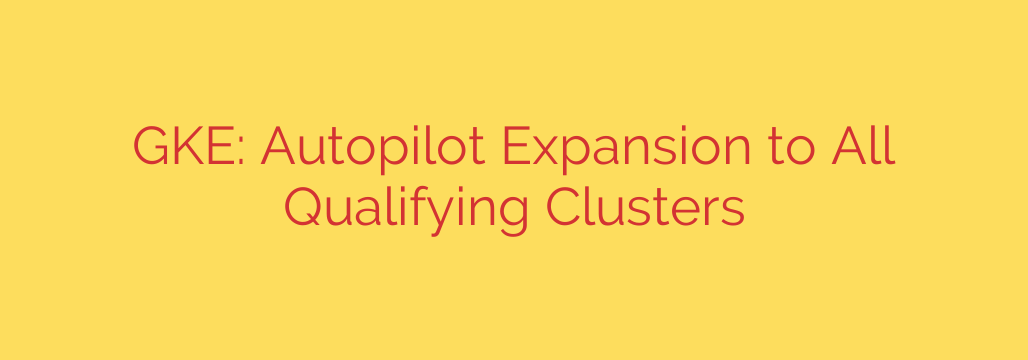
GKE Autopilot and Standard Unite: A Powerful New Hybrid Model for Your Clusters
Managing Kubernetes clusters can be a delicate balancing act. On one hand, you need the granular control and customization of a standard cluster. On the other, the dream of a hands-off, fully managed environment is incredibly appealing for reducing operational overhead. In a significant move for cloud infrastructure management, these two worlds are now merging, creating a powerful new hybrid approach within Google Kubernetes Engine (GKE).
Previously, developers had to choose: build a GKE Standard cluster for maximum control or create a GKE Autopilot cluster for a managed, serverless-like experience. Now, that choice is becoming a thing of the past. GKE is automatically upgrading qualifying Standard clusters to support Autopilot workloads, effectively transforming them into hybrid clusters that offer the best of both worlds.
What is This GKE Autopilot Expansion?
At its core, this update allows you to run both Standard and Autopilot workloads side-by-side within a single, unified cluster. This isn’t a forced migration; your existing node pools and configurations in Standard mode remain untouched. Instead, this enhancement adds the capability to deploy new workloads using the Autopilot model without provisioning a separate cluster.
For eligible clusters, this is an automatic and seamless process. GKE handles the background configuration to enable this hybrid functionality. The result is a single cluster environment where you can:
- Continue managing specific node pools for specialized workloads that require custom machine types or daemonsets.
- Deploy new applications as Autopilot pods, letting Google handle the node provisioning, scaling, and management entirely.
The Key Benefits of a Hybrid GKE Cluster
This evolution in GKE isn’t just a minor feature update; it represents a paradigm shift in how you can manage your Kubernetes resources.
Ultimate Flexibility: You no longer face a binary choice. Have a stateful application that needs a specific machine type with persistent disks? Deploy it on a Standard node pool. Need to deploy a new stateless microservice quickly? Deploy it as an Autopilot pod and forget about the underlying infrastructure. This allows you to match the operational model to the workload’s specific needs.
Streamlined Operations: This change dramatically simplifies cluster management. Instead of maintaining separate clusters for different operational needs, you can consolidate them. This reduces administrative complexity, simplifies networking, and provides a unified view of all your workloads.
Enhanced Security Posture: Workloads running in Autopilot mode benefit from a highly secure, managed environment. Google applies security best practices, automatic patching, and node hardening by default. By offloading the management of nodes for a portion of your workloads to Google, you reduce your attack surface and operational security burden.
Intelligent Cost Optimization: Autopilot operates on a pay-per-pod resource consumption model. You are billed for the CPU, memory, and storage your pods request while they are running. For stateless or bursty applications, this can be far more cost-effective than paying for an entire virtual machine that may sit idle. You gain the cost benefits of a serverless model for eligible workloads without sacrificing control elsewhere.
Actionable Steps: How to Leverage the New Hybrid Model
Getting started with this new capability is straightforward. If your cluster has been automatically upgraded, you can begin deploying Autopilot pods immediately.
1. Verify Your Workload Mode:
When you deploy a new pod, you can let GKE decide where to place it. To explicitly schedule a pod in the Autopilot environment, you can use a nodeSelector in your pod’s YAML manifest.
To target the Autopilot environment, add the following selector to your pod specification:
spec:
nodeSelector:
cloud.google.com/gke-provisioning: autopilot
This tells GKE to run this pod on Autopilot-managed infrastructure, which will be provisioned automatically if needed.
2. Deploy Your Workload:
Apply your manifest as you normally would using kubectl apply -f your-manifest.yaml. GKE will read the node selector and handle the rest. You don’t need to create a node pool or worry about scaling.
3. Monitor and Optimize:
Keep your existing workloads on your Standard node pools and begin deploying new, suitable applications (especially stateless web apps and APIs) to Autopilot. Use Google Cloud’s cost management tools to monitor the financial impact and see how the pay-per-pod model optimizes your spending.
This convergence of GKE Standard and Autopilot marks a significant step forward, offering a more flexible, secure, and cost-effective way to run containerized applications on Google Cloud. It empowers teams to focus more on building great applications and less on managing the underlying infrastructure that runs them.
Source: https://cloud.google.com/blog/products/containers-kubernetes/gke-autopilot-now-available-to-all-qualifying-clusters/








